![[Translate to English:] Operation](/fileadmin/_processed_/8/3/csm_IMG-20150527-WA0023_0925d65000.jpg)
Welcome dear students!
On this page you can find out more about our role in your veterinary curriculum and the points of contact you will have with us.
Our task is always to promote interest and knowledge in cattle and to make you want to work on and with this special and wonderful animal species.
We try to achieve this by giving you a lot of contact with the patient. With us, you are always directly involved.
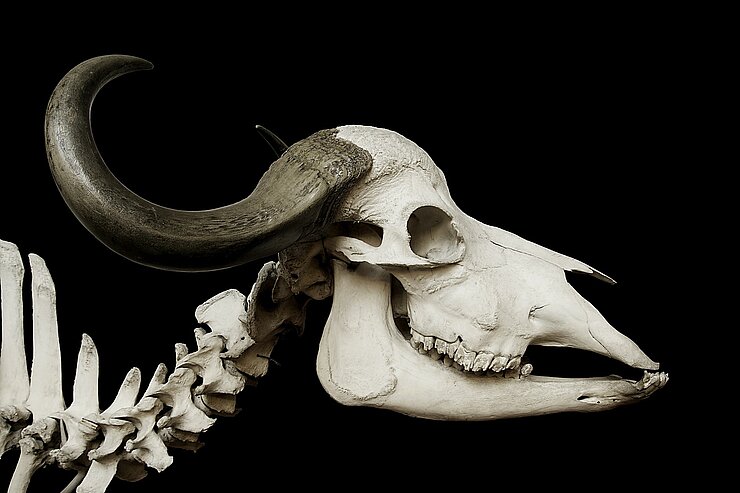
1st - 3rd semester
Unfortunately, we have no contact during the first 3 semesters. However, you can prepare yourself intensively for the cattle by paying particular attention to the horned and rumened animals in anatomy and physiology and getting ready for the fascination of cattle!
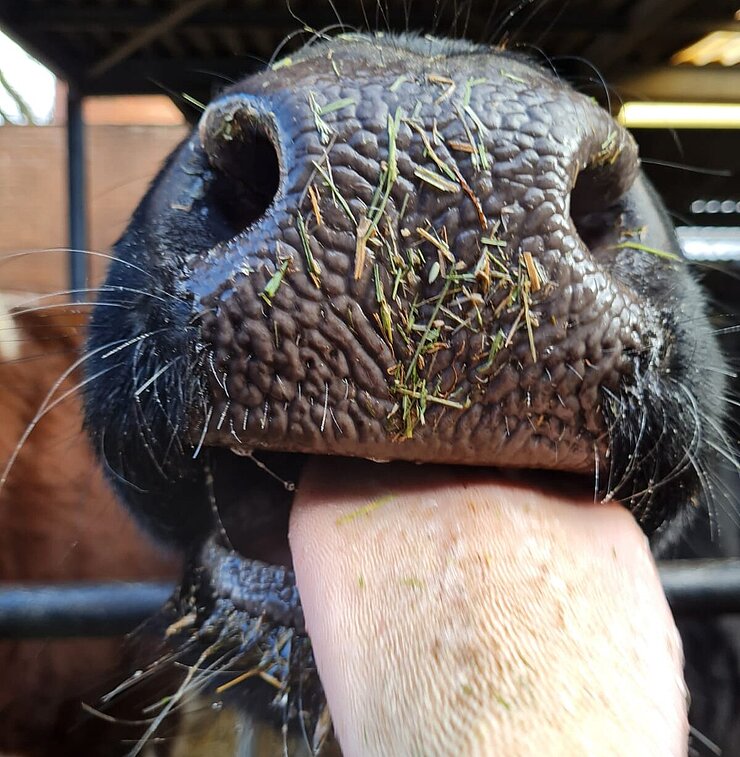
4th semester - Here we go!
Propaedeutics is our first point of contact.
Here you will learn how to handle the animal and the details of the clinical examination of cattle.
There are both lectures and direct contact with the animal in small groups so that you can get on the same wavelength as the cattle as quickly and intensively as possible!
Please ensure that certain rules apply to your stay at the clinic. These rules are intended to ensure that the handling of the animals is always safe and minimises risks for both parties.
The first special routes for you:
Participation in the evening treatment
Once you have successfully completed the propaedeutic exercise, you are allowed to join us in the evening treatment (always from 6 pm) and seek contact with the animal, treat it and be present during procedures (surgery or obstetrics, intensive care).
Please sign up in advance on the list at the registration desk and read the safety regulations of the cattle clinic
P.S.: 50% of the evening treatments can be credited as compulsory electives...
Become a student assistant
Our student assistants usually work with us for one year and support us in our clinical work, especially at night and at weekends
- the advantages:
- You get permanent, intensive and direct contact with cattle earlier than anyone else
- You will operate, treat and diagnose from the very beginning - you will see many different cases and can thus expand your theoretical studies with some real-life experience
(Vacancies for student assistant jobs are advertised every six months / information and application deadlines can be found on TiHo-Moodle under "Course *0340 (WS) or *0840 (SS)")
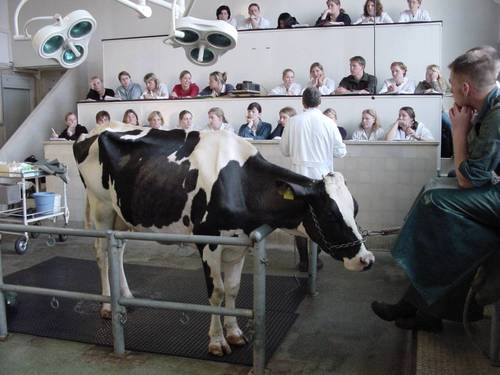
up to the 8th semester
In addition to the lectures on cattle, which introduce you to the topics of internal medicine, surgery and reproduction and make the complex nature of ruminants a little more "digestible", there are also the very illustrative clinical demonstrations. In those, specific cases are discussed practically and theoretically on the animal that is in the lecture theatre during the lecture. Here you can make direct findings on the animal and link these to the clinical picture.
In some clinical demonstrations, we even perform surgeries directly in front of you during the lecture!
You also write case reports during this phase. Similar in its basic nature to the clinical demonstrations, here you will be let loose on the animals on your own and have to take care of the findings and theoretical elaboration on your own!
Still not enough? Our numerous compulsory elective courses shed light on the topic of cattle from all sides and are a must for every future ruminant enthusiast!
Have a look!
You can find all the courses we are involved in in the course catalogue(simply select Clinic for Cattle from the facilities)
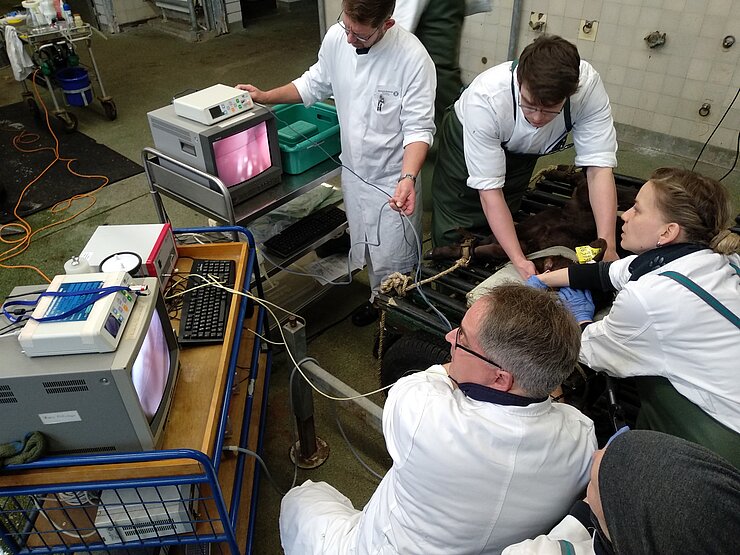
The Practical Year - the state examination
From the Practical Year (PJ) onwards, you now have the following options:
- more cattle
- 4-week internship (TAppV § 57,1)
- 16-week internship (TAppV § 57.2)
- Practical year cycle choice: Cattle clinic
- less cattle (we do not talk about this option)
For those who are undecided
Internships outside the PJ cycle
With this option, you can choose between a 4-week and a 16-week ("splitable") internship
- Collaboration in the clinic, insight into all areas
- aseptic surgery
- septic surgery
- Treatment and ward rounds
- Participation in herd health visits
- great to get a feel for medicine in the cattle sector and if you are unsure whether you want to take the clinical exam on cattle
PJ cycle in the Clinic for Cattle
General
Good choice! 10 weeks cattle full speed ahead
Go through our programme at the Clinic for Cattle and take the clinical examinations of the state examination on the animal species cattle!
The programme is structured as follows
- daily from 8 a.m. to 1 p.m. participation in clinical activities in the relevant departments (more details below)
- from 2 pm practical courses (e.g. suturing or surgical exercises) but also intensive theory to work through the cases in the clinic
- every Friday a cross-section on a topic relevant to cattle with many perspectives through the participation of other institutes in the event
- Excursions with the herd management team
- Participation in the night shift
1) Ressorts
Orthopaedics & septic surgery
- Orthopaedics
-
- Lameness diagnostics // (including X-ray and ultrasound)
- Claw care with knife and angle grinder
- Exposing and relieving defects in the claw area (including block gluing)
- Joint puncture and irrigation
- Wrapping of bandages
- Fracture treatment
- Septic surgery
- Claw amputation, claw joint resection
- Cleavage of abscesses / treatment of wounds
- Tail amputations
- Ultrasound diagnostics / endoscopy
-
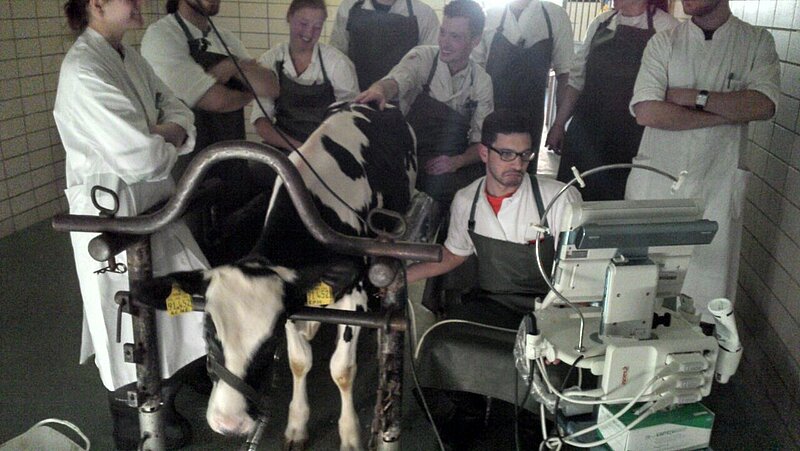
Treatment
Here you will work directly on the animal and treat our patients together with our assistant doctors, student assistants and animal carers!
In this way you will expand your skills on animals and at the same time learn more about the treatment methods and possibilities on cattle.
Aseptic surgery
Here you will be in the operating theatre with us and take part in the operation.
You will learn more about the possibilities of anaesthesia in cattle, why it is better to operate on cows in standing position and gain your first insights into aseptic surgery in large ruminants through direct participation in the operations!
We operate:
- Laparotomies (from the left and right) with indication:
- Diagnostic
- Abomasal displacements (to the left or right)
- Caecotomy
- Intestinal resection / intestinal obstruction
- Caesarean section
- Ruminotomy
- Teat surgery
- Open and closed amputations
- Surgical and conservative treatment of teat injuries
- Teat stenosis
- Bulbous evisceration
- Endoscopic abomasal fixation according to Jannowitz
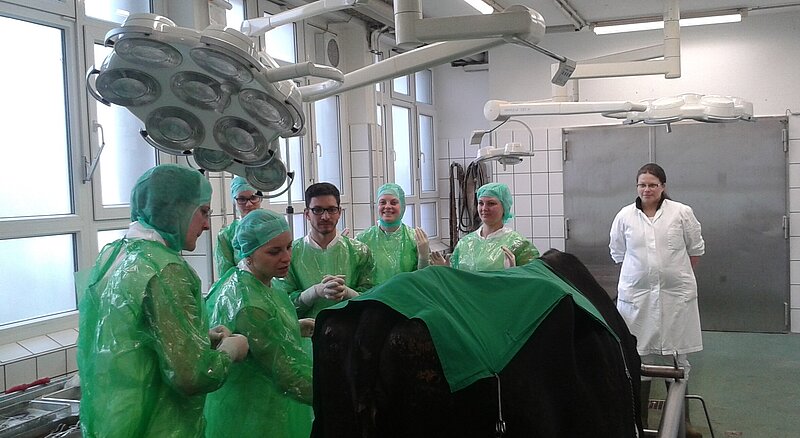
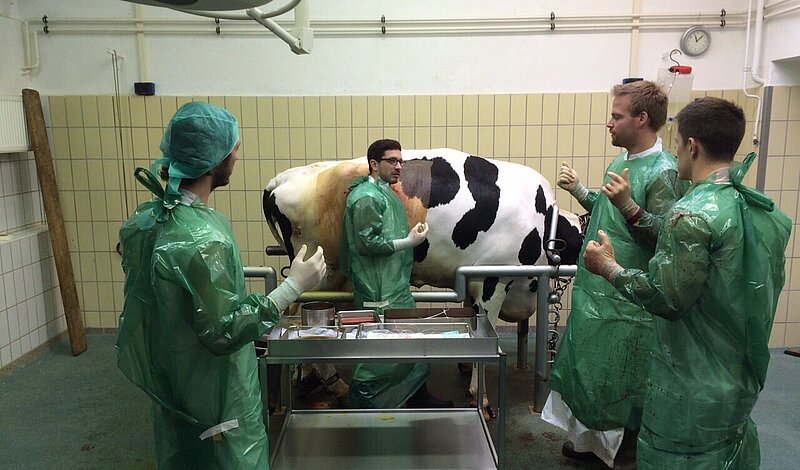
Clinical Rounds
Take part in the ward round and ask our ward round leaders questions (or let them ask you questions...)!
This will give you a better insight into the diagnostic approach and possible therapies, but you will also see the cow as it progresses and evaluate the animal's condition every day.
2) Practical and theoretical classes
We believe that everyone who goes through our PJ cycle and later works in cattle practice should be able to perform a caesarean section and a ruminotomy.
- For every 4-5 PJ students, we buy a cow in labour, monitor her closely until she gives birth and then you perform a caesarean section and care for the calf on your own (we are there, of course).
- For every 4-5 PJ students, we buy a cow on which you perform a ruminotomy independently
- We also take you to Ruthe, our Research and Teaching Farm, every Wednesday - there you can carry out hoof care and other procedures on your own at a tiltable operating table and a hoof trimming stand. We will of course accompany and advise you.
In addition to these special features and case discussions with presentations of current cases from the clinic, you will also attend the following courses:
| Non-invasive interventions |
|---|
| Claw care (theoretical) |
| Introduction to caesarean section |
| Examination of recumbent animals / CNS |
| Examination of teats and udder |
| Ultrasonography |
| Operating procedure abomasum (theoretical and practical) |
| Searching for and using information (a course by our library for literature research) |
| Teat surgery |
| Laboratory diagnostics |
| Radical claw surgery (theoretical and practical) |
| Fluid therapy |
| Discussion and preparation of cases with our herd health staff |
| Intestinal resection (theoretical and practical) |
| Gynaecological exercises on our clinic-own cows (weekly) |
| Fracture treatment (theoretical and practical) |
| Taking and analysing x-rays |
| Head, testicles and tail exercise (= lots of surgery [practical]) |
| Seminar on animal diseases |
| Fetotomy (theoretical and practical) |
| Drug law in cattle practice |
3) Interdisciplinary Classes
In our interdisciplinary classes, we give you an in-depth look at selected topics in cattle medicine and also put ligth on them by different views of specialists from other institutes - this gives you an even better overview of these topics
| Transition cow / rumen acidosis |
|---|
| Transition cow / peritparturient hypocalcaemia, DCAB |
| Transition cow / prevention of abomasal displacement |
| Infertility as a herd problem |
| Claw diseases as a herd problem |
| Enzootic bronchopneumonia |
| Paratuberculosis as a herd problem |
| Udder health and milking as a herd problem |
| Crisis management of animal diseases |
| Herd management |
4) Excursions with our Herd Health Service
Here you will travel to dairy farms with the herd management team and carry out routine examinations as well as, for example, hygiene scorings, assess the milking procedure, evaluate husbandry conditions and evaluate other areas on the farm.
As a result, you will learn more about cattle as animals a part of a dairy herd and become more familiar with the aspects that you need to consider as a vet on a farm and that can affect an individual animal or an entire herd of cattle.
5) Night Duty
During this time, you are not in the clinic during the day - but exciting things also happen here at night. From 5 p.m. until the next morning, you will live in our PJ flat, help with evening treatment, but also experience the care of emergency patients and be actively involved in decision-making and therapy.


